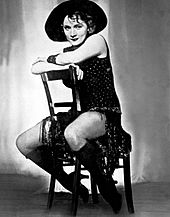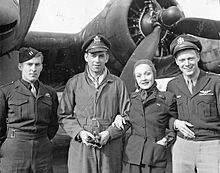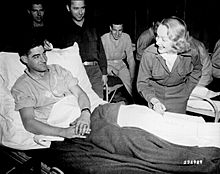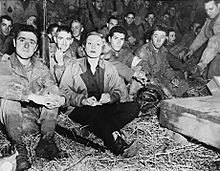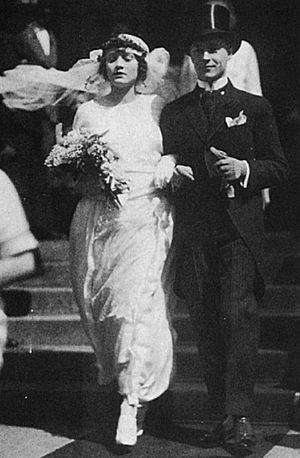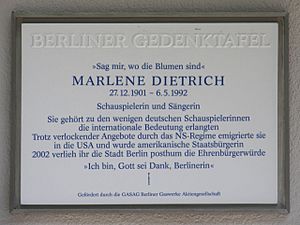Marlene Dietrich facts for kids
Quick facts for kids
Marlene Dietrich
|
|
|---|---|
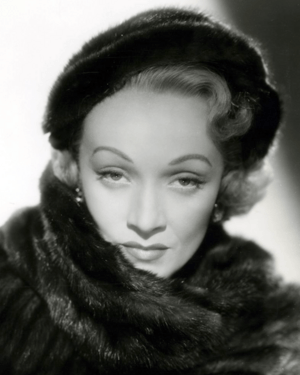
Dietrich in 1951
|
|
| Born |
Marie Magdalene Dietrich
27 December 1901 Berlin, Germany
|
| Died | 6 May 1992 (aged 90) Paris, France
|
| Resting place | Städtischer Friedhof III |
| Nationality | German until 1939, American |
| Occupation |
|
| Years active | 1919–1984 |
| Spouse(s) |
Rudolf Sieber
(m. 1923; died 1976) |
| Children | Maria Riva |
| Relatives |
|
| Signature | |
 |
|
Marlene Dietrich was a famous German and American actress and singer. Her amazing career lasted from the 1910s all the way to the 1980s!
She became well-known in the 1920s in Berlin, performing on stage and in silent films. Her role as Lola-Lola in the movie The Blue Angel (1930) made her famous worldwide. This led to a contract with Paramount Pictures in Hollywood. She starred in many Hollywood films, often directed by Josef von Sternberg. Some of her most famous movies include Morocco (1930) and Shanghai Express (1932). Marlene was known for her glamorous and unique look, becoming one of the highest-paid actresses of her time.
During World War II, Marlene Dietrich was a very important entertainer for the United States. She helped soldiers and worked to improve their spirits. She also helped German and French people who had to leave their homes. For her efforts during the war, she received special awards from the United States, France, Belgium, and Israel. In 1999, the American Film Institute called her one of the greatest female movie stars of classic Hollywood.
Contents
Early Life in Berlin
Marlene Dietrich was born Marie Magdalene Dietrich in Berlin, Germany, on December 27, 1901. Her family lived in the neighborhood of Rote Insel in Schöneberg. Her mother, Wilhelmina, came from a wealthy family who owned a jewelry business. Her father, Louis, was a police officer. Marlene had an older sister named Elisabeth.
Marlene's father passed away in 1907. Later, her mother married Eduard von Losch, a soldier who died in 1916 from injuries during World War I. Marlene's family often called her "Lena" or "Leni." When she was about 11, she combined her first two names to create "Marlene."
She went to school in Berlin, finishing in 1918. As a teenager, she learned to play the violin and loved theater and poetry. An injury to her wrist stopped her dream of becoming a concert violinist. But by 1922, she got her first job playing violin in a small orchestra for silent films in Berlin. She only worked there for four weeks.
Marlene started her stage career as a chorus girl in different shows in Berlin. In 1922, she tried out for a drama school but didn't get in. However, she soon found work in theaters as a chorus girl and played small roles in plays.
Starting Her Film Career
Marlene Dietrich's first small role in a film was in The Little Napoleon (1923). She met her future husband, Rudolf Sieber, while working on the movie Tragedy of Love in 1923. They got married in Berlin on May 17, 1923. Their only child, a daughter named Maria Elisabeth Sieber, was born on December 13, 1924.
Throughout the 1920s, Marlene continued to act on stage and in films in Berlin and Vienna. She appeared in plays by famous writers like William Shakespeare. She also gained attention in musicals and revues. By the late 1920s, she was getting bigger roles in movies like Café Elektric (1927) and The Ship of Lost Souls (1929).
Her Big Career
Working with Josef von Sternberg
In 1929, Marlene Dietrich got her big break playing Lola Lola, a cabaret singer, in the German film The Blue Angel (1930). The director, Josef von Sternberg, is often credited with "discovering" her. This movie introduced Marlene's famous song "Falling in Love Again."
Because The Blue Angel was so popular around the world, Marlene moved to the United States in 1930. She signed a contract with Paramount Pictures in Hollywood. The studio wanted to make her a big star, similar to Greta Garbo. Von Sternberg helped her a lot, giving her gifts and even coaching her on how to act. He helped her create her famous image as a glamorous and mysterious woman.
Between 1930 and 1935, Marlene starred in six films directed by von Sternberg. In Morocco (1930), she played another cabaret singer and earned her only Academy Award nomination. Other successful films they made together included Dishonored (1931) and Shanghai Express (1932).
Von Sternberg was known for his amazing skill in lighting and filming Marlene. He used light and shadow in special ways to make her look incredible. Their movies together were very stylish and beautiful to watch. Many people agree that neither of them reached such artistic heights again after they stopped working together.
The Late 1930s
After working with von Sternberg, Marlene made Desire (1936) with Gary Cooper. This movie was a success and showed she could also do romantic comedies. She then made some expensive films that did okay, but her popularity seemed to drop a bit. By 1938, some American movie theater owners even called her "box office poison," meaning her movies weren't making enough money.
While in London, Marlene said that Nazi Party officials offered her big contracts to return to Germany and be a top film star. She refused these offers and applied to become a U.S. citizen in 1937.
In 1939, Marlene took a different kind of role in the western-comedy Destry Rides Again with James Stewart. She played a cowboy saloon girl named Frenchie. This role helped restart her career, and the song "See What the Boys in the Back Room Will Have" from the film became a hit. She played similar strong female characters in other films like Seven Sinners (1940) with John Wayne.
World War II Efforts
Marlene Dietrich had strong beliefs and wasn't afraid to share them. In the late 1930s, she helped create a fund to help Jewish people and others escape from Germany. In 1939, she became an American citizen and gave up her German citizenship.
When the U.S. entered World War II in December 1941, Marlene was one of the first public figures to help sell war bonds. She traveled across the U.S., selling more war bonds than any other star.
In 1944 and 1945, she went on two long tours for the USO. She performed for Allied troops in places like Algeria, Italy, France, and even entered Germany with generals. When asked why she risked being so close to the German lines, she said, "out of decency." She performed songs from her films, played the musical saw, and even did a "mindreading" act.
Marlene also recorded songs in German for a secret project to help lower the spirits of enemy soldiers. One of these songs was "Lili Marleen," which was popular with soldiers on both sides. The head of the Office of Strategic Services (OSS) thanked her for her help.
After the war, Marlene reunited with her sister Elisabeth and her family in Germany. Marlene's mother had stayed in Berlin during the war. Marlene helped her sister and brother-in-law, protecting them from being accused of helping the Nazis.
In November 1947, Marlene Dietrich received the Medal of Freedom from the U.S. government for her amazing work entertaining troops during the war. She said this was her proudest achievement. The French government also gave her the Légion d'honneur for her wartime efforts.
Later Film Roles
While Marlene Dietrich didn't have as many leading roles in films after the war, she still appeared in several notable movies. She worked with famous directors like Billy Wilder in A Foreign Affair (1948) and Alfred Hitchcock in Stage Fright (1950). In the 1950s, she was in films like Witness for the Prosecution (1957) and Orson Welles's Touch of Evil (1958). Her last major film role was in Judgment at Nuremberg (1961).
Stage and Cabaret Performances
From the early 1950s until the mid-1970s, Marlene Dietrich mostly worked as a cabaret artist. She performed live in large theaters in major cities all over the world.
In 1953, she was offered a lot of money to perform live in Las Vegas. Her show was very successful, and she continued to perform in places like London.
Marlene hired Burt Bacharach as her music arranger in the mid-1950s. Together, they made her nightclub act into a bigger, more theatrical show. Her performances included songs from her movies and popular songs of the day. Bacharach's arrangements helped her limited singing voice sound amazing. She often started her show in a glamorous dress and then changed into a top hat and tails. This allowed her to sing songs usually sung by men, like "One for My Baby."
People had different opinions about her live shows. Some found them magical, while others were more critical. Marlene used special makeup, wigs, and lighting to keep her glamorous image as she got older.
When Marlene returned to West Germany for a concert tour in 1960, she received a mixed reaction. Some Germans felt she had betrayed her homeland by supporting the Allies during the war. Despite protests, her shows attracted huge crowds. She was warmly welcomed by others, including Berlin Mayor Willy Brandt, who also opposed the Nazis. The tour was a success artistically, but it was hard on her emotionally.
She also toured Israel around the same time, where she was very well-received. She even sang some songs in German, breaking an unofficial rule against using German in Israel. She later received an award from Israel for her support of the Jewish people.
Marlene performed on Broadway in New York City twice and received a special award in 1968. She continued to perform until September 1975. When asked why she kept performing, she said it was hard work and she wouldn't do it if she didn't have to.
As she got older, Marlene's health declined. She had several injuries, including a broken thigh bone from a fall on stage in Australia in 1975. This fall largely ended her performing career.
Later Years in Paris
After her stage fall, Marlene Dietrich mostly stayed in her apartment in Paris. She spent the last 13 years of her life mostly in bed, only allowing a few close family members and employees to visit. During this time, she wrote many letters and made many phone calls. Her autobiography, Nehmt nur mein Leben (Take Just My Life), was published in 1979.
In 1982, Marlene agreed to be part of a documentary film about her life called Marlene (1984). However, she refused to be filmed, so the director, Maximilian Schell, only recorded her voice. The film used her interviews along with clips from her career. It won several awards and was nominated for an Academy Award.
Even in her later years, Marlene remained interested in world events. Her daughter and grandson said she kept in touch with world leaders by phone, including Ronald Reagan and Mikhail Gorbachev. In 1989, her message to save the Babelsberg Studios (where she filmed The Blue Angel) was broadcast on BBC Radio. She also spoke on television about the fall of the Berlin Wall that same year.
Death and Legacy
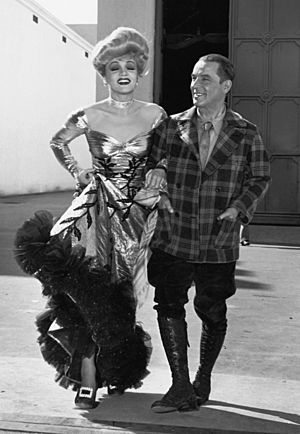
Marlene Dietrich passed away on May 6, 1992, in her Paris apartment at the age of 90. Her funeral was held in Paris, with about 1,500 people attending inside the church and thousands more outside. Her coffin was covered with the French flag, and three medals, including France's Legion of Honour and the U.S. Medal of Freedom, were displayed. The priest said she "lived like a soldier and would like to be buried like a soldier."
Marlene had wished to be buried in her hometown of Berlin. Her body was flown there on May 16, 1992. Her coffin was draped in an American flag, showing her status as an American citizen. As her coffin passed through Berlin, people threw flowers onto it, a tribute to her love for flowers. She was buried in the Städtischer Friedhof III cemetery in Schöneberg, near her mother and the house where she was born.
After her death, a large part of Marlene's belongings was sold to a German film museum. This collection included over 3,000 clothing items, 15,000 photographs, and 300,000 pages of documents, including letters with famous people.
Personal Life
Marlene Dietrich carefully created her public image, but her private life was mostly kept secret. She spoke German, English, and French fluently.
In May 1923, Marlene married Rudolf Sieber, who later worked for Paramount Pictures. Their only child, Maria Riva, was born in Berlin in 1924. Maria later became an actress. When Maria had her own son in 1948, Marlene was called "the world's most glamorous grandmother." After Marlene's death, Maria wrote a book about her mother.
Marlene was raised in the Christian faith, but she lost her faith during World War I. She wrote in her autobiography that she couldn't believe in a God who would allow such a war.
Marlene Dietrich's Legacy
Marlene Dietrich was a huge influence on fashion designers and other stars. She was known for her unique style, often wearing clothes that blurred gender lines, like suits and top hats. In 2017, a special dress with 2,000 crystals and 150 LED lights was made to honor her. It was inspired by her wish for a glowing dress in 1958.
In 1992, a plaque was placed at her birthplace in Berlin. A postage stamp with her picture was issued in Germany in 1997.
For some Germans, Marlene Dietrich was a controversial figure because she supported the Allies during World War II. However, in 1997, a central square in Berlin was named Marlene-Dietrich-Platz to honor her. The plaque there says she was a "Berlin world star of film and song" who showed "dedication to freedom and democracy, to Berlin and Germany."
Marlene Dietrich was made an honorary citizen of Berlin in 2002.
The U.S. Government gave Marlene the Medal of Freedom for her war work, which she said was her proudest honor. The French Government also gave her the Légion d'honneur. She received other awards, including the Medallion of Honor from Israel.
Marlene Dietrich is mentioned in many popular songs from the 20th century, like "Where Do You Go To, My Lovely?" and Madonna's "Vogue." She has inspired artists and musicians for decades.
In 2000, a German movie called Marlene was made about her life. In 2017, she was honored with a Google Doodle on her birthday, designed by drag artist Sasha Velour, who was inspired by Marlene's fashion and strong views.
See also
 In Spanish: Marlene Dietrich para niños
In Spanish: Marlene Dietrich para niños




